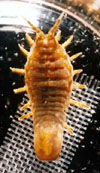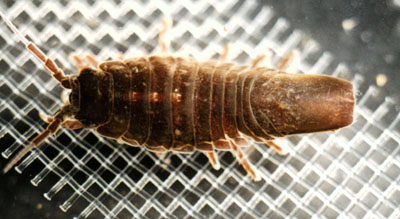Idotea metallica in the German Bight - an indicator of a
warming trend in the North Sea
Lars Gutow
Biologische Anstalt Helgoland - AWI
The marine isopod Idotea metallica exhibits a strictly
neustonic life-style. The species is associated with surface drifting
objects such as macroalgae, wood, plastic bottles, or remains of fishing
nets. Due to their resistance to natural decay, abiotic substrates, in
particular, represent a suitable vehicle for dispersal by large scale
water currents sometimes resulting in a cosmopolitan distribution.
Permanent populations of I. metallica occur predominantly in
subtropical waters of the Mediterranean or the east coast of North
America. The species spreads from America over the entire North Atlantic
area. It is carried along by the Gulf stream to Western European waters
from Scandinavia down to the Iberian Peninsula. Apart from a few records
from the Dutch and the Norwegian coasts the species had never been found
in the North Sea proper.
 |
However, in 1994, we encountered I. metallica for the first
time off the island of Helgoland (German Bight). This was in the course
of a long-term survey program (made since 1988) on the isopod fauna
associated with surface drifting objects. A slight increase in
population density in 1995 was followed by the species' complete
disappearance from that area after the severe winter 1995/96. However,
since 1998 I. metallica re-appeared in higher numbers than ever
before, with a relatively stable proportion of 1-2 % of the total Idotea
fauna found on drift material.
A comprehensive data set on sea surface temperatures measured daily
at Helgoland since the early 1960s revealed that the last decade of the
20th century was characterised by extraordinarily mild winter
temperatures. Whether this temperature anomaly is a first sign of a
long-term global warming trend or just a temporary phenomenon caused by
the North Atlantic Oscillation (NAO) has as yet to be decided. However,
the simultaneous occurrence of the warm adapted I. metallica and
mild winter temperatures appears to be more than purely accidental.
Since drift material could only be collected from spring to autumn,
laboratory experiments were performed in order to reveal the species'
status in winter. The question was whether I. metallica was able
to survive winter periods in the North Sea under typical and slightly
warmer temperature conditions. - The answer was: no.
 |
Since 1998 I. metallica has re-appeared in higher numbers than ever
before
Experimental populations reared under such winter temperatures were
not able to produce offspring and finally went extinct within about six
months. The lower temperature limit for reproduction was determined as
13 °C. Since the period with water temperatures below 13 °C lasts for
about 8 months in the German Bight, animals cannot survive until spring
to be able to establish a new population.
Consequently, summer populations found in the German Bight must
derive from specimens introduced into the North Sea every year anew.
Presumably, specimens of I. metallica may have always been there
but in too low numbers to be easily detected. However, as the North Sea
warmed up this resulted in an extended reproductive period for I.
metallica allowing the population to become more prolific and thus
more conspicuous. Accordingly, the recent conspicuous and regular
occurrence of I. metallica is potentially a suitable and
sensitive indicator for the ecological relevance of a warming trend in
the North Sea.
|
